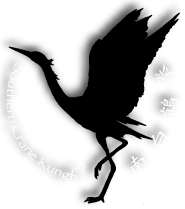By Heather McLean, Instructor, Southern Crane Kungfu
People come to us to learn kungfu, thinking it will be great fun to learn to hit things while getting fit. Few come to us to learn Shuang Yang, our Taoist Temple style of soft qi gung. But to be good at kungfu, you need to learn the soft side as well.
However, students are not interested in Shuang Yang because, it seems, the word ‘soft’ puts them off. Yet ‘soft’ in the context of kungfu does not mean squidgy, floppy, or so relaxed you’re practically asleep, and it definitely does not mean weak.
‘Soft’ energy is that fluidity of constant, effortless, undulating movement that good kungfu practitioners have, which gives you precision and accuracy that is developed through learning slowly, not charging in and throwing your arms around enthusiastically as juniors tend to do.
The problem that juniors always have is that they are too ‘hard’; not ‘hard’ as in macho or muscular, but their energy is ‘hard’ energy. They tend to have too much yang – too much fire – and they overcook movements. They have no fluidity or ‘softness’, which is the key to being good at kungfu.
If you look at the yin yang symbol, you will see a small dot of white yang inside the black yin shape, and a small dot of black yin inside the white yang shape. Yang is hard energy, yin is soft energy, but both contain each other and both are linked together in the eternally tail-chasing yin yang symbol. They cannot be separated, and one cannot exist without the other.
Inside kungfu there is softness, and inside soft chi gung there is hard energy. Both are martial styles, but you learn each one differently, and each one teaches the practitioner something different. Yet you can’t have one without the other. The best kungfu students also study Shuang Yang and they always have throughout the history of our Club. The facts speak for themselves. Get to class.
